Youtube Behind Story of Drag Queen Baby Love
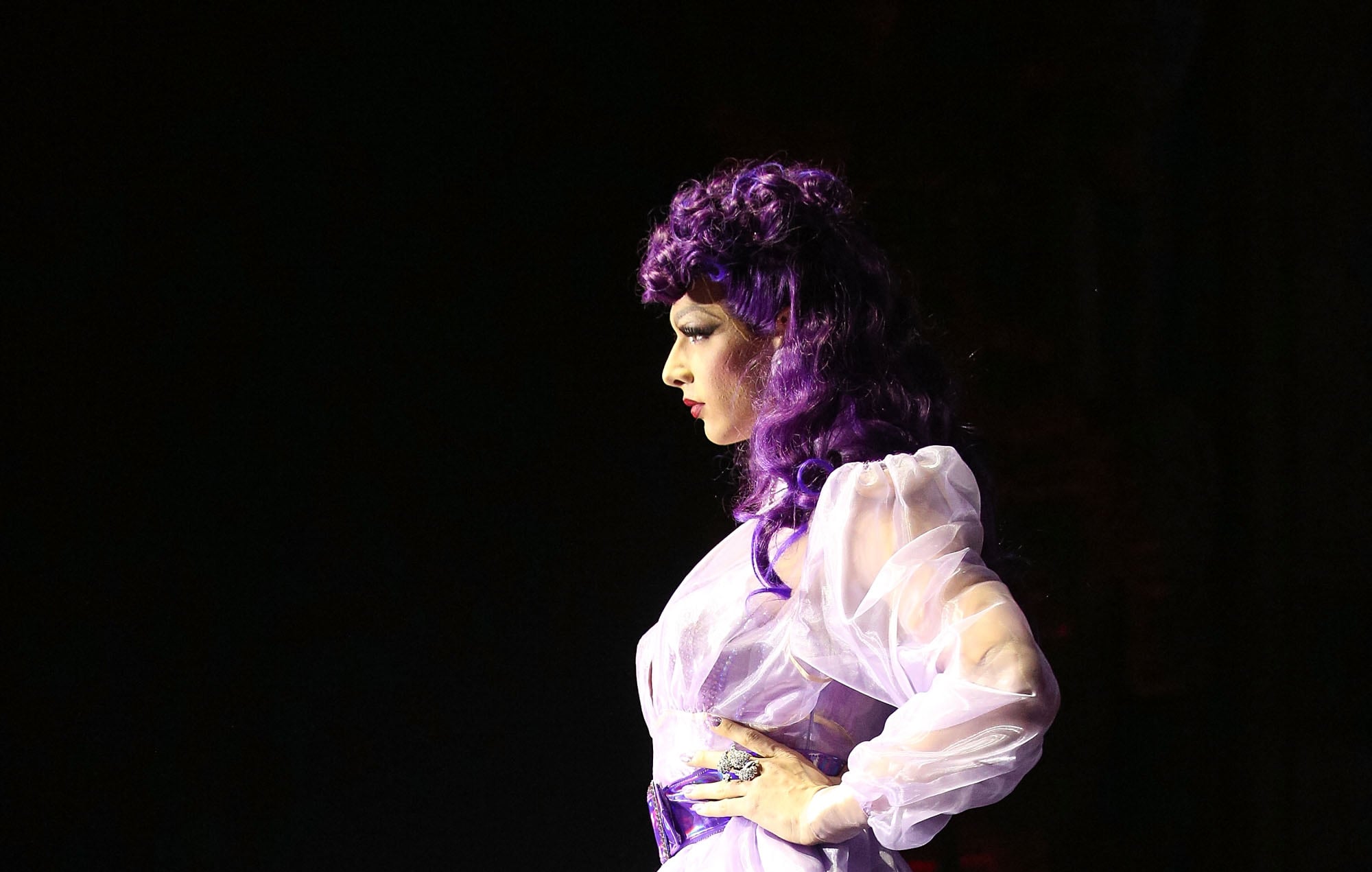
In the 21st century, a drag queen is not merely a homo who wears women'southward clothes; a elevate queen is an entirely separate entity. When and then impeccably dressed and flawlessly painted, the person underneath the queen disappears almost completely. Oftentimes, I've heard drag performers depict their personas equally though they were another person. They've plunged their hands deep downwardly into their ain psyches and pulled out the weirdest, fiercest, and most theatrical parts of themselves, then mashed them together to grade something new. A grapheme. An alter ego. A super-"she"-ro, if you will.
In this moment, elevate civilization is bigger and more pop than it's ever been. RuPaul's Elevate Race has simply had its most successful flavor yet. With its move from Logo to VH1, information technology racked upwards almost 1 million viewers for the premiere and held stiff with over 800,000 season finale viewers. The show'south 3rd All Stars season is about to launch, mark a new contest between some of the peak drag queens in mainstream media. And even outside of RuPaul's Elevate Race, queens have been able to build incredible followings via social media, live performances, YouTube, and podcasts.
Drag hasn't always been received this way. In fact, this sort of public awe — sometimes, information technology borders on worship — of drag queens has actually only cropped upward in the past decade or 2. Before that, elevate was submerged deep in underground clubs and back-alley bars. And before that, it was an exaggerated and integral role of the theater culture. The fact is, drag has been a office of our culture for centuries. And every era and every new iteration of the art class has been crucial to the shape and success of drag today.
Where did it all begin? Few fans of the art form realize that the earliest forms of cross-dressing — only the act of wearing clothes that are designated as belonging to the opposite sexual activity — are actually rooted in religious rites. In his book Elevate Diaries, Jonathan David focuses on ii long-agone origin points: ancient ceremonies (Native American, indigenous South American, and Ancient Egyptian) and Japanese theater. David writes that "cross-dressing was widely documented among the Aztecs, Incas, and Egyptians, among other great civilizations of the past, and exists today in tribal ceremonies around the world." Imagine religious rites of initiation, invocations of the gods, calling downwardly the rains, and warding off evil spirits as occasions that would call for drag in these cultures.

Japan: an player applies makeup in a Kabuki theater (circa 1950).
Image Source: Getty / Three Lions
"In Japanese theater," David writes, "drag divides the Kabuki and Noh dramas. Noh derives from Dengaku, a folk dance associated with rice planting and fertility, and in its ancient, cocky-enclosed spiritual world, 'female person' actors wearing masks follow stylized routines in a complex and rarefied design of symbolic gestures." Kabuki, of course, is a form of Japanese theater that many more than people are familiar with. David notes that it rose to popularity in the 17th century, and "is more popular and less ritualistic than Noh." In Kabuki theater, the female impersonators are "carefully fabricated-upward, speak in falsetto voices, and move to suggest the essence of femininity."
Some other book that shed quite a flake of lite on what we might call the "sacred" drag queen is titled Elevate: A History of Female Impersonation in the Performing Arts. Roger Baker also pulls a thread back to ancient civilizations, noting that drag "presided over the creation of drama in ancient Greece where masked actors played Hecuba and Clytemnestra." Meanwhile, in England, Baker writes that "formal drama came, literally, from the church. In an endeavor to aid the illiterate and, well, less intelligent members of the congregation better understand church worship, parts of the mass were dramatized in very elementary ways."
Somewhen, these religious performances began to have a life of their own. In fact, these eclectic sets of dramas were eventually removed from the church entirely. Rather than perform the stories in hallowed chapel halls, local Guilds would instead accept the reins. In fact, very specific groups would tackle the narratives most applicative to their trade. "Thus the Vintners would perform the Wedlock of Cana," Baker writes, "the Shipwrights would present Noah and his Ark, while the Goldsmiths could use the Adoration of the Magi equally a suitable excuse to brandish their precious products."
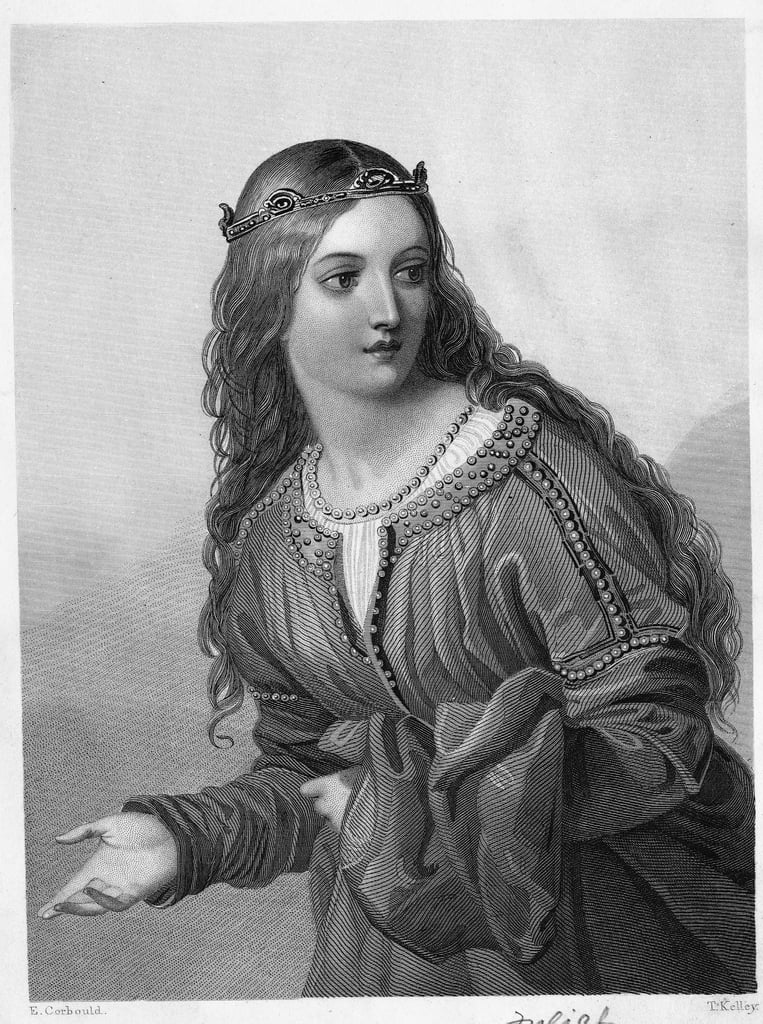
An engraving of Juliet in William Shakespeare's Romeo and Juliet (Thomas Kelly and Edward Corbould).
Prototype Source: Getty / Bettmann
As for the cantankerous-dressing component of these sacred performances, women were omitted from the arts and crafts entirely. "Women played no active part in the services and the offices of the church, then the original acting was washed exclusively past men, choirboys assisting the clerks and playing women's roles when required," Bakery notes in Drag. From in that location, it'southward not hard to connect the dots. Recreations of these religious stories eventually were farther dramatized, sometimes including subplots that didn't exist in the original text. Earlier long, performances grew more than secular until the dawn of a new era: original dramatic plays.
When Western theater transitioned from its religious roots to something much less sacred, the rules excluding women were kept intact. It's worth noting, here, that the concept of drag was entirely divorced from homosexuality at this time. It wasn't until much later on that the two became inextricably linked.
In researching this piece, I reached out to Joe East. Jeffreys, a elevate historian who teaches theater studies at NYU Tisch Drama. Jeffreys has chronicled quite a fleck of drag culture in his own time, and archives his work on personal YouTube and Vimeo accounts. When information technology comes to the presence of women in the theatrical space, Jeffreys told me "it was unseemly or improper for a female to nowadays herself on such full public brandish."
In Elevate, Baker writes about the primeval original "plays." In this new iteration of theater, the performances "took to the streets with the improvisation of the strolling players livening upwardly formal scripts. Past the beginning of the sixteenth century, troupes began to utilize courtyards of public inns equally a performance infinite." Baker also notes the continued efforts to keep theater as an activity meant just for men. "To find a woman interim in a public playhouse would accept offended non only on religious grounds, but besides be seen as a shocking example of inappropriate behavior."
Equally functioning transitioned into a globe of more traditional theater spaces and Shakespearean soliloquies, these ethics connected to be upheld. Baker writes of young boys who joined acting troupes and companies. "If he had a suitable face and a slim torso, and so his first assignments would exist in female roles," he says. "Rarely does Shakespeare, or the other dramatists of the period, introduce more than than three women in any ane play, which suggests that at that place were few boys of adequate proficiency at whatsoever given time. Smaller female roles would be doubled past by youths playing messengers, spear carriers, and all-purpose nobles."
"A woman acting in a public playhouse would have offended non only on religious grounds, but also be seen as a shocking instance of inappropriate behavior."
As a matter of fact, the get-go appearances of Shakespeare's nearly iconic female characters were all believed to first be portrayed by men. "The first Ophelia is thought to have been Nathaniel Field, who ultimately became equally famous every bit role player Richard Burbage the peachy Elizabethan heavy," Baker writes. "The get-go Lady Macbeth might accept been Alexander Cooke . . . A swain called Robert (or Bobbie) Gough (or Goffe) is oft named as the first Juliet, and likewise every bit the first Cleopatra."
While this theatrical history provides an illustrious chronicle of men dressing as women, Jeffreys, our drag historian, made certain to draw a distinction between drag culture's theatrical roots and the drag queen as an entity in itself. "Were the Elizabethan male child actors drag queens?" he asked. "I think the term goes beyond them." In fact, the first true so-named drag queens didn't emerge until the 19th and 20th centuries.
In Elevate, Baker says cross-dressing remained a pervasive function of theater culture until the belatedly 19th century, when it began to accept a new course. Female impersonators adult their own vaudeville acts, wherein they created caricatures of women. Jeffreys corroborated this fact, writing that elevate "was a popular act in the numerous vaudeville theatres across America from the turn of the 19th Century until the late 1930s." This moment in time birthed such mocking personas equally the "wench" and the "primadonna." But in order to find the first iterations of the "drag queen" as we know her today, nosotros have to pinpoint the moment drag culture became inextricably linked with the gay community.
Jeffreys told me that this link didn't really happen until the 1930s. "Before then, the scientific field of sexology was forming and began to talk about the 'third sex,'" he said. "The third sexual practice was discussed as a feminine man or a masculine woman who desires members of the same sexual practice. By the 1930s this scientific conversation had worked its mode into the popular civilization and linked drag with homosexuality." This connectedness marked the switch: drag culture no longer belonged to directly, white men. In this moment, nosotros witness the emergence of the first truthful drag queens. "Drag queens are non only males who apparel and perform as female but likewise have some connexion to a gay scene," Jeffreys said. "Until gay bars emerged, either clandestinely or legally, the drag queen was bounded by private parties, and fifty-fifty then police raids were possible." I was lucky enough to get a quick lesson in the first true gay elevate queens from Jeffreys as well:
"The starting time truthful drag queens rest in little-remembered confined. Jose Sarria at San Francisco's Black Cat in the 1950s is possibly an early on example if we go downwardly this path. There were, of form, men who entertained as women: performing at this fourth dimension in places like the 82 Club in New York Metropolis or touring the country with the Gem Box Revue, only they worked in forepart of a largely heterosexual audition and would take offense at being called a drag queen. To them, this was a lower classification of the streets and bars and amateur compared to the female impersonation they offered."
Jeffreys makes a point in classifying the different kinds of drag that occurred at the time. While other female impersonators existed, the drag queens were integral to the new, gay-friendly spaces that began to pop upwardly.

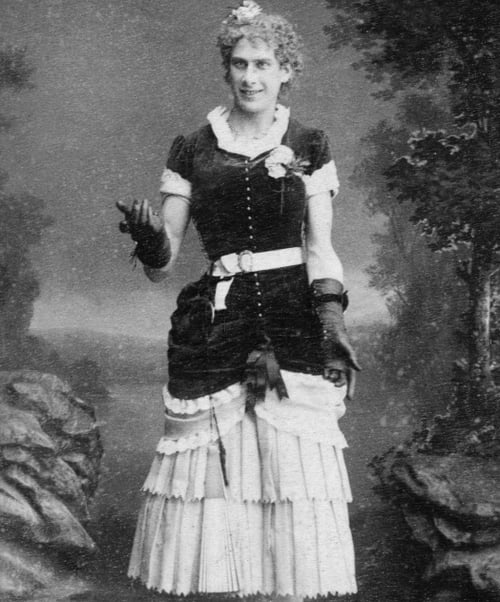
Douglas Byng as Queen Elizabeth I (circa 1935), unknown crossdressing man (circa 1880).
Image Source: Getty / Gorgon Anthony / Corbis
The mod iteration of the elevate queen developed in these surreptitious clubs over the adjacent handful of decades. Meanwhile, in the public eye, female impersonation was given a comedic edge; cross-dressing was portrayed in film and TV as a punchline, or an object of strangeness. One classic example is Some Like It Hot (1959), which follows a farcical, almost Shakespearean story of two men posing as women. In Alfred Hitchcock's Psycho (1960), Norman Bates is a deranged human who dresses every bit his female parent earlier killing people. Who could forget the eerie shrieks of the score as the shower pall pulls back to reveal the poorly styled wig on Norman Bates'southward caput?
These cinematic forays offered Shakespearean carryovers as well: Twelfth Night and As You Like It, which both deport plotlines involving female impersonation, were adapted into films in the 1930s. There are plenty more examples of this mainstream treatment of drag. But there had to be a point when the LGBTQ+ customs'south elevate queens strutted dorsum into the spotlight.
Now that we're venturing into the tardily 20th century, we tin see how drag queens finally began to become a more than visible part of arts and civilisation. Jeffreys told me, "drag was a powerful move in NYC during the late 1980s and 1990s, due in large part to the explosively experimental East Village functioning scene, and its products such every bit the Pyramid Club and the annual Wigstock drag festival."
At this point, drag queens were amassing large followings. Some of the first drag icons emerged: Divine was a legend out of Baltimore who frequently worked with the manager John Waters. There was something striking about a 300-pound drag queen who gave no f*cks — Divine notoriously consumed dog sh*t on camera at the end of Pink Flamingos. That kind of shock value was intrinsic to the elevate persona. Divine's incredible presence fifty-fifty served as inspiration for Ursula the Ocean Witch in The Little Mermaid. According to the story, none of the character designs for Ursula worked, "until an animator named Rob Minkoff drew a vampy overweight matron who everyone agreed looked a lot like Divine."
And speaking of Wigstock, which Jeffries mentioned in passing above, Lady Bunny is the founder and creator of the event. In Elevate Diaries, Lady Bunny tells the story of her commencement performance in NYC, which speaks to a drag queen's complete willingness to make a fool of herself. A elevate queen challenges yous to express mirth with her, and laugh at her. That's what makes her so alluring and captivating. "My first performance in New York was lip-syncing to 'I Volition Survive' at the Pyramid. I was so inexperienced that the spotlights were blinding me, and I vicious off the stage," she recalled. "I somehow managed to get back up, wig askew and one shoe missing, and finished the number, which was a crowd-pleaser, and I was a fixture at the Pyramid for the side by side six or seven years."
Later in that same interview, Lady Bunny talks nearly how she'd been packaged upwardly as something that was reviled. Again, she captures the trigger-happy, unyielding spirit of someone who is so sure of who they are and what they're doing that nix can drag them downwardly.
"I was on twenty/20 in a clip that was put out past some religious group trying to show how twisted gays were and how they had to be stopped. They showed footage from Wigstock the year it was in Marriage Square . . . Then it cut to the women watching the video in some church building, shaking their heads and digging in their purses to provide contributions to become rid of me, and people like me. I love that thought. Merely I'm not going away! They're going to have to come up with a lot of contributions to become rid of me."
In that location are many more than historic queens: Australia'south Dame Edna, Pepper LaBeija (oft referred to as the Queen of Harlem Elevate Balls), and Flawless Sabrina, whose story I heard from the fantastic Zackary Drucker just last year.

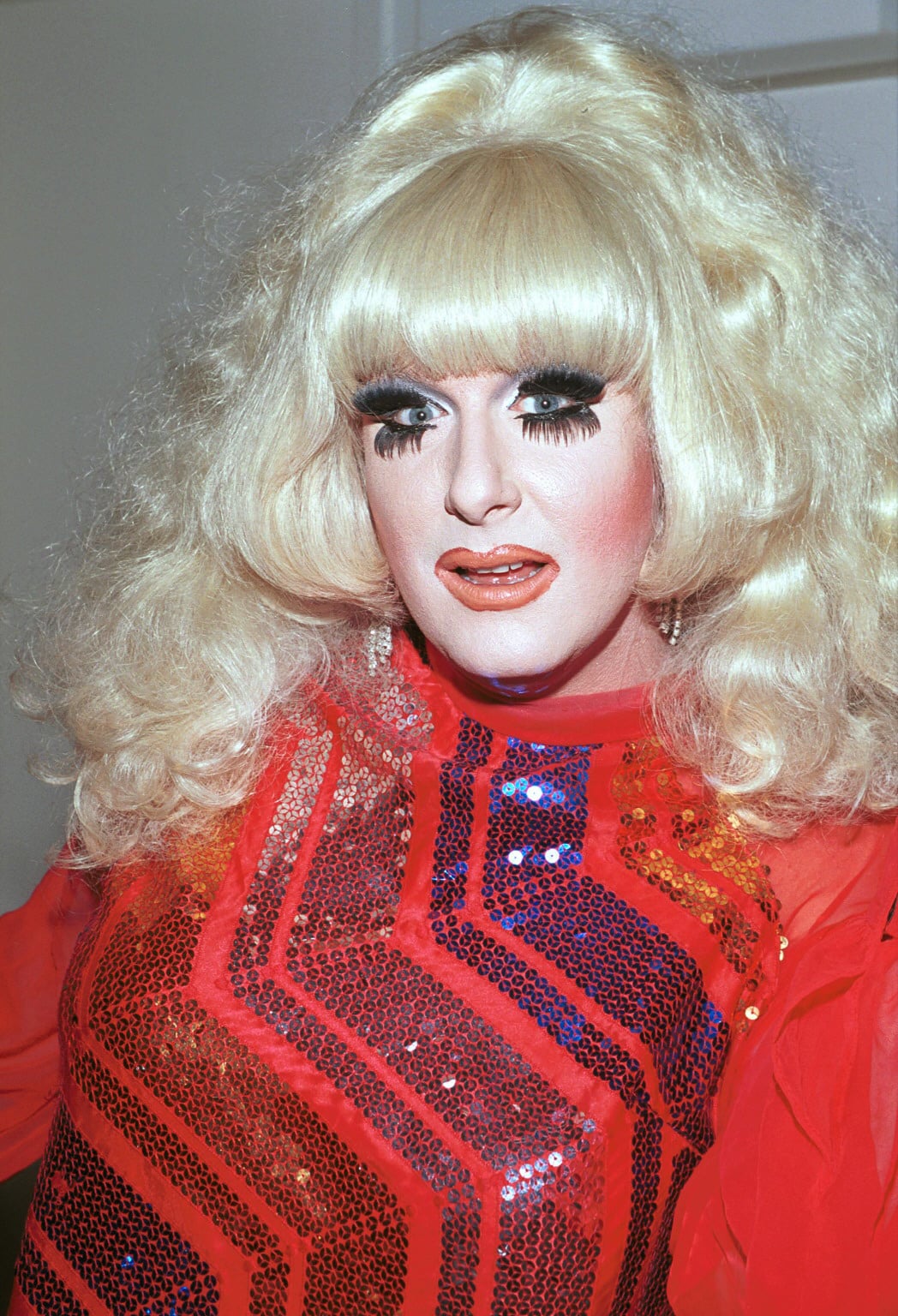
RuPaul (1993), Lady Bunny (2000).
As truthful drag queens came out of the shadows, mainstream media continued to paint more portraits of female interpretation. But there was a notable shift. The elevate queen wasn't quite every bit much of a punchline, or a garish creature to shine a spotlight on. New films, like The Adventures of Priscilla, Queen of the Desert (1995), depicted drag queens in more flattering light. There were documentaries in this time, too. LGBTQ+ history was being documented in ways information technology had never been depicted before.

A withal from Paris Is Called-for (1990).
Paris Is Burning (1990) chronicled the aforementioned Harlem drag balls, where Pepper LeBeija reigned supreme. As nosotros descend into this unfamiliar world, we witness the truthful artistry of a drag ball, which was like a sporting event for the LGBTQ+ customs. These balls marked a rubber space for individuals to express themselves and find escape.
But Paris Is Burning offers so much more than that. These subjects, over again, bear witness what it means to be a drag queen. To be self-bodacious and to wholeheartedly have an unshakeable faith in oneself. This film offered glimpses into drag culture: we were getting iconic quotes left and correct. "Right about at present, these next 40 or so years I'thousand gonna exist here," Pepper LeBeija says. "I'm going to alive. And for those children who tin can't take the fact that I still await youthful? Ha! Endure. No bags, no lines. Lovely."
"Shade comes from reading. Reading came first. Reading is the real fine art form of insults," a drag queen named Dorian Corey says in another function of the picture show. "You get in a smart scissure, and everyone laughs and kikis considering y'all found the flaw and exaggerated information technology, then you've got a skilful read going. I don't tell you you're ugly, merely I don't have to tell you, because you know you're ugly. And that's shade." As nosotros've moved forrad, these aspects of drag culture have just get more than prevalent. Later all, even RuPaul'due south Elevate Race has a "reading" challenge every flavor.
At that place was as well Wigstock: The Movie in 1995, which similarly gave u.s. a look at a safe space for art, love, and self-expression. Here, we could run across drag performers truly expressing themselves in a secure and unencumbered way. It marked a new kind of liberation in the drag community, i that drag queens specifically hadn't experienced before.
And then, of course, there's RuPaul herself. Mayhap the most well-known drag queen in history, RuPaul has built an incredible empire. RuPaul was hot on the New York scene, simply her large break is largely idea to have been the "Dear Shack" music video with the B-52s, which was released in 1989. From at that place, it was a steady climb with 1993'due south "Supermodel" video, which positively exploded. Only it was also Ru'south ability to stay in the spotlight that ultimately helped her stay relevant. After all, she'southward racked up a whopping 65 acting credits over the form of her career.
In 2009, everything inverse. With the premiere of RuPaul's Drag Race, drag queen culture was able to mount a new, more exposed platform. Drag queens were no longer something you lot had to seek out; no more than did fans have to hunt around for local drag shows at gay bars in their cities. RuPaul'south Drag Race gave us a place to run across queens in the condolement of our own homes, on a weekly footing. And these weren't but any queens: they were some of the all-time America had to offering.
In the near-decade since the series premiere, we've seen nine seasons, ii all-star seasons, and more 100 queens. The third season of All Stars is here. Season 10 is right around the corner. If VH1 tin can keep upward the momentum, we may notice ourselves in a space where some course of the show is almost ever airing. Tin you imagine 52 straight weeks of Ru?! We'll keep our fingers crossed.
Information technology's not just that RuPaul'due south Drag Race gave fans a better opportunity to witness drag. There'due south an educational aspect of the bear witness that's almost impossible to miss. Those who aspire to do drag learn about so many facets of drag civilisation. Each of these 100 unique queens is helping to establish a broad range of elevate styles, aesthetics, and characters.
These lessons are non confined to the drag customs. Interwoven are issues that affect the LGBTQ+ community at large. In flavor one, Ongina revealed an HIV diagnosis. In season 8, Kim Chi talked about how she'd kept her drag persona from her parents. In season 9, Sasha Velour and Valentina got real about their struggles with eating disorders while Peppermint came out every bit transgender. Over the years, it's become clear that RuPaul's Drag Race is not just a reality competition. It's a wacky, dramatic microcosm that, all likewise often, speaks to the human experience.
In order to go an fifty-fifty better perspective on drag at the dawn of the 21st century, I spoke to 3 drag queens who are gear up to compete in RuPaul'due south Drag Race All Stars, season iii: Thorgy Thor, BenDeLaCreme, and Kennedy Davenport. Each of their unique perspectives helps to paint the picture of a mod drag queen. But they too clued me into something else: Yes, drag is a collective movement, and in that location is a (sort of) traceable history. But as soon as drag went hugger-mugger, every bit soon every bit it began to develop into the fierce culture of elevate queens we see today, there is no i specific way for drag to manifest. Every city has its own drag families, its own drag culture, and its own drag history.
These three queens gave me insight into their own experiences with drag in Chicago, Dallas, and Brooklyn, NY. But drag, I've realized, may be a vast ocean that tin can never be completely mapped out.
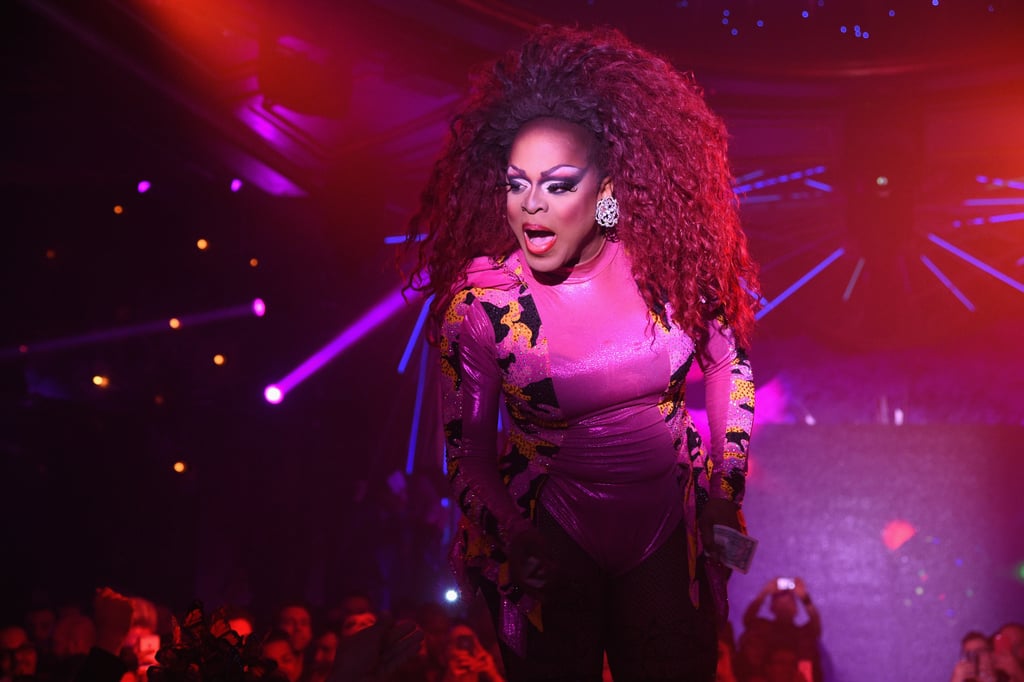
Kennedy Davenport (2015).
Down in Louisiana, Kennedy Davenport was introduced to elevate about 20 years ago. When we spoke on the telephone in January, she recalled a memory from but 16 years old: "It was my offset time I ever saw it. Snuck in a club, saw a drag . . . I call up it was the combination of seeing my first female impersonator and the immediate love and attention I got the start fourth dimension being on stage that got me hooked." To Kennedy, Texas is a elevate mecca. "Dallas was the place to exist back in the 24-hour interval, when information technology came to drag," she said. "Back then, the children were really lost. They were being rejected by their families, and actually had nowhere to get. So the people, the queens, would take them in, requite them a identify to stay, and that'due south where the origin of drag family unit and mother came in."
Luckily for Kennedy Davenport, elevate was not a family dealbreaker. "My begetter, thank God, never close the door on me. The door was always open up. But I just, I was non the type of person to disrespect my begetter," she said. "So, anytime I feel like I wanted to practice what I wanted to do, I just left. But I left to some other secure place. Some people that made sure I went to school, made certain I stayed on the right track." When I asked almost her drag family and elevate mother, she told me the story:
"I have one elevate queen, the commencement elevate queen to ever put me in elevate. That'south usually who becomes your female parent. She made me her kid. And then she put me in drag, and that's where I got the bones of putting my base and pulverization on. So, when I turned 17, that's when I met the mother that I accept today. Then, my mother is Kelexis Davenport, and she'south been my mother since I was 17, and I'm 37 at present. And she's however my elevate mother to this mean solar day. Information technology goes beyond just the phase and drag. I mean, she's helped me in my personal life. She knows my family unit, my family unit knows her. And that'southward what gay family is all about."
BenDeLaCreme, every bit it turns out, did quite a bit of personal elevate research back in college. BenDeLaCreme echoed the words of Jeffreys, but made an interesting betoken.
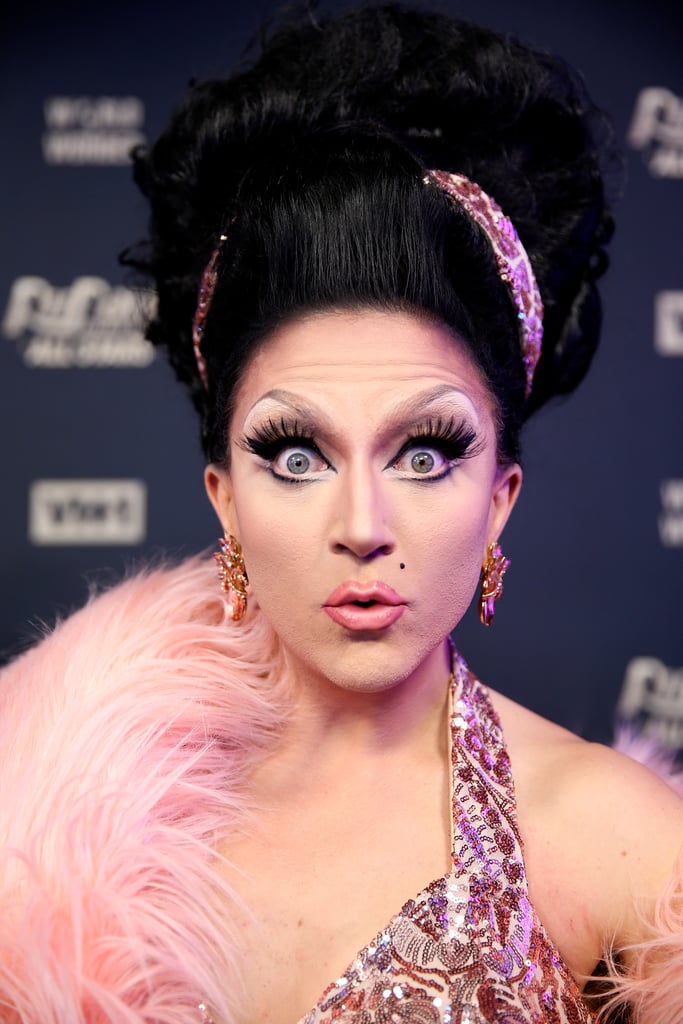
"A lot of the queens in these underground clubs . . . drag was built out of those shadowy spaces where people plant a identify to be empowered," she said during our telephone interview. "And I call back that really influences the sense of independence, the fact that information technology was and then self-independent. I retrieve if elevate had sort of merged in more than popular culture, the way that it is now, it wouldn't be what it currently is."
While BenDeLaCreme grew up in Connecticut, she didn't emerge every bit a drag queen until later. "My experience of [drag] in Chicago at the time was that it was very cute drag queens performing ballads, which I have the utmost respect for, but information technology was non what I was interested in. I was interested in sort of more storytelling on phase . . . Then I did that for a while, performed in those spaces, and it resonated with some people. Some people were excited that I was doing something different, but other people merely looked at me, confused."
What I found most interesting about BenDeLaCreme's journey is the intersection between drag and caricatural. "I sort of transitioned into caricatural, and I was working caricatural stages. There'south a lot of men in burlesque as well, simply I wasn't really in the drag scene. I really worked more than in these other scenes, and I actually was really, sort of found my first kind of queer space amid women. And so, I think that has really also influenced my point of view."
When I asked for more insight into this burlesque experience, she revealed that it traced back to Washington State. "I had a personal feel with getting involved in burlesque. And then . . . 12 years ago, 11 years ago, something like that, I moved to Seattle. And at the time, at that place was this real renaissance. I was then fortunate to move there at the time, considering there was this collision of cabaret artists, and circus artists, and burlesque, and drag." She added, "Caricatural is about heightened femininity. It'south about the performance of femininity and that'southward what drag is about. And I think that's why they're and then related."
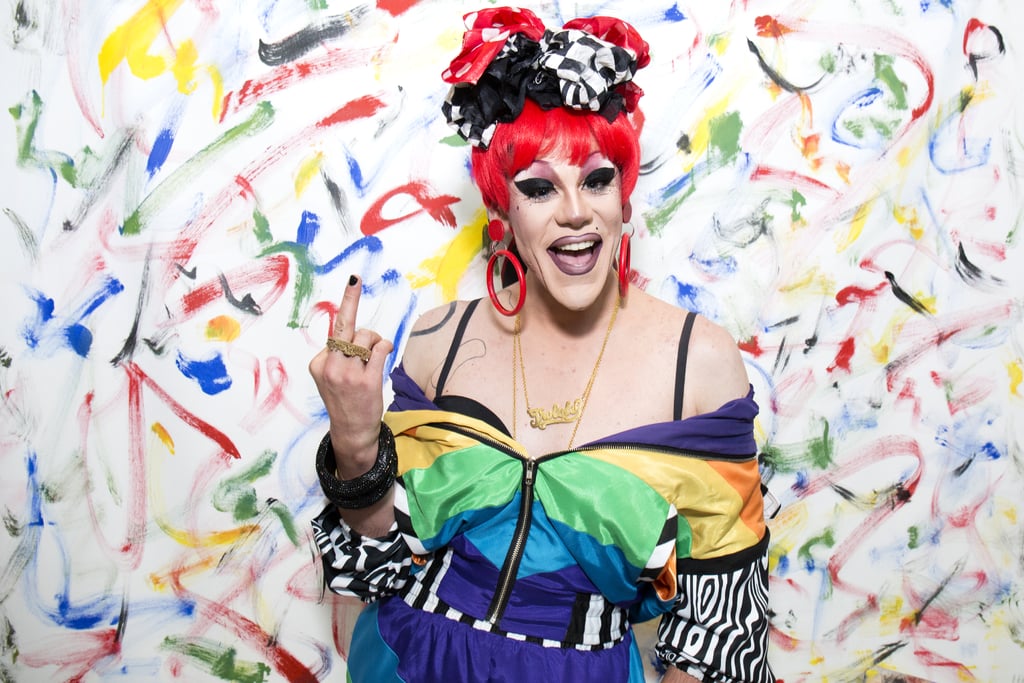
And so there'southward Thorgy Thor, whose education and entry in drag perhaps mirrors the experiences of many new and aspiring elevate queens in the mod age. Thorgy Thor did not have a drag mother or a drag family unit. In fact, Thorgy Thor did not start out doing drag at all. "I never came from a drag house or I never had a drag mother. I was never from that kind of upbringing in drag. I was just this kid who slept and woke up with nightmares and dreams and made it into art because I couldn't help it . . . I am a gay man. Gay culture, makeup is fun. So it got more than feminine along the way, but that's really where I started."
And what about elevate history? Kennedy Davenport told me that a lot of history was oral; it came from other queens. Simply for Thorgy Thor, information technology was all self-driven research: "I first started being like, 'Oh. Elevate. Drag is fun. That's what I am. I'm like a elevate queen, I guess,"' she said. "This is pre-Facebook. I'm like a pre-Facebook, pre-Instagram, pre-YouTube queen. So when I decided like, 'Oh. I take to paint my face like a drag queen,' whatever that means, I went to Google and typed in drag queen, and pictures of Miss Understood would popular upwards. Lady Bunny would popular upwardly. RuPaul would pop up . . . There was no zooming in! It was just, like, looking at pictures and being like, 'Oh. That's what a drag heart looks similar? Let me try that.'"
And so it goes. These three queens came from entirely different corners of the country. Elevate is far-reaching and nearly impossible to pin down. But there's one matter that has succeeded in creating a unified perception of drag. Sure, different iterations of drag all the same exist: everything from gender-f*cking to goth to camp. Just 1 affair managed to package upwardly everything, for better or worse, and present it to the public: RuPaul's Elevate Race.
"Nosotros are in the Ru era of elevate, and those 100+ performers who have been contestants on the contest reality prove tin at present practice quite well for themselves," Jeffreys told me. "Television and other media platforms are powerful things that the stage of your local gay bar can inappreciably offer." It's piece of cake to encounter what he means. Sasha Velour, who won season nine of RuPaul's Drag Race, has more than 800,000 followers on Instagram. Alaska Thunderf*ck, who won All-Stars season two, has a whopping 1.2 million. When drag was hole-and-corner, queens could hope to garner a cult following in their city, exist it NYC or Dallas or wherever. Now, a drag queen tin can truly be a global star.
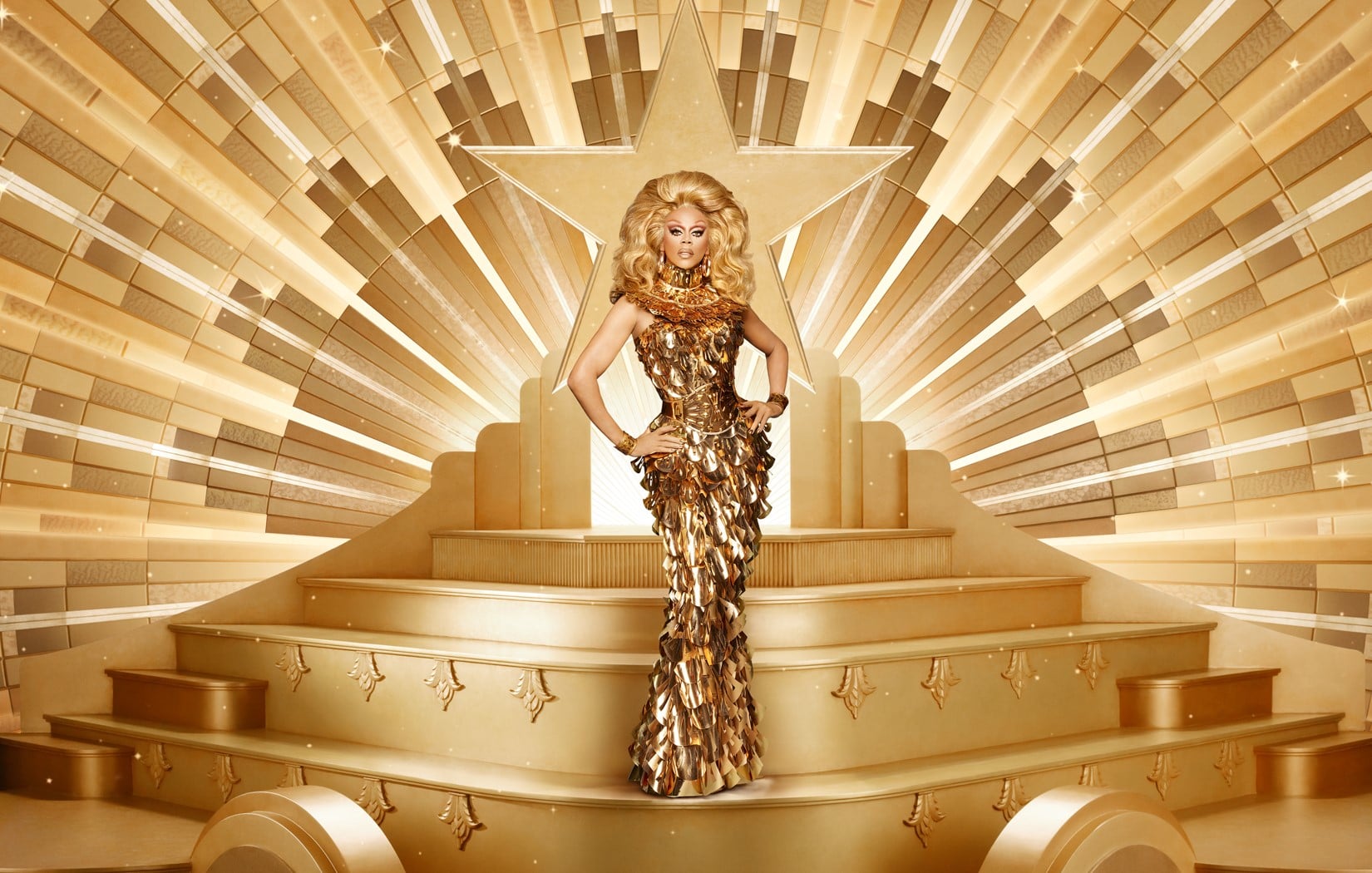
"I think information technology's just brought a bigger life, a broader demographic, to embrace," Kennedy Davenport told me. "I think it definitely changed the game. I mean, y'all have dissimilar forms to drag now. People are coming into their own when it comes to the art of female impersonation, and are actually being true to themselves when it comes to representing whoever or whatsoever they desire to be once they get up in drag."
Thorgy Thor had a similar indicate of view: "We've actually come a long way. But information technology'due south nearly, what practise you say at present? We've got and so much power. Nosotros realize we accept then much power, and information technology's kind of phenomenal how we harness that, because drag has get mainstream.
"I mean, absolutely it was Elevate Race," BenDeLaCreme said. "I hateful, our current drag resurgence is conspicuously all due to Drag Race, which is incredible."
"We are in the Ru era of elevate."
At present, at that place's nowhere to look but forward. RuPaul's Elevate Race has put drag culture under an umbrella for the mainstream public to digest. Simultaneously, information technology does mean drag is reaching new people that, mayhap, it's never reached before. This opens a window to new definitions and interpretations of drag. Who knows what's on the horizon? What's the next stride in the renaissance? "Elevate's current renaissance, coupled with digital platforms, is pushing information technology in new directions," Jeffreys said. "Our increasing acceptance that gender is nonbinary, non ane or the other but more of a wave or spectrum, is also moving traditional elevate into newer directions."
As for the queens themselves? BenDeLaCreme thinks the pendulum may come swinging back. "I recollect that drag will go along to be super potent, but I do recollect that information technology'll, in some ways, move back into a thing where merely the really passionate performers and not-performers feel empowered to embrace drag and explore it . . . even if it's a few decades off."
"I just call up that drag is probably just going to open more than doors for freedom," Kennedy Davenport said. "And a bigger line of respect for information technology. I think more than people will learn to respect it every bit an art form."
"Where it's going?" Thorgy asked. "I don't know. Perchance I'chiliad not the person to inquire, but I'1000 too not psychic. I have no f*cking idea. Just I'm going to tell you what I'one thousand going to be doing: only working harder and harder to just kick my ass as an artist and observe the right environment to cultivate my creative ideas. And hopefully, kick my butt to get them out there to people. And then. That'due south what I would say."
While mainstream drag will continue to present drag queens in traditional ways, this scene is a breastwork of experimentation and pushing the envelope. Lest we forget that elevate kings exist, and they are continually carving out their ain infinite in drag culture. And the fact that the ever-expanding styles of drag accept allowed for new kinds of queens to form, leaving space for even more experimental drag to rush forth. Drag, by definition, is only going to get weirder, more than expansive, and more prevalent. And beyond that, cloak-and-dagger drag is yet on the cut edge of the culture itself. If that alone, and the success of Elevate Race, are any indication, drag is only going to become weirder, more expansive, and more prevalent.
Source: https://www.popsugar.com/news/History-Drag-Drag-Queen-Culture-44512387
0 Response to "Youtube Behind Story of Drag Queen Baby Love"
Post a Comment